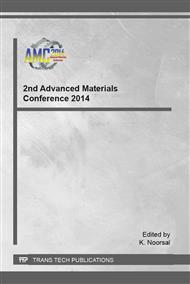p.33
p.38
p.45
p.50
p.55
p.60
p.65
p.70
p.75
Effect of Methylcellulose on the Hydrophilicity of Chitosan 3D-Porous Scaffold
Abstract:
This paper work proposes the idea of super hydrophilic chitosan development in porous sponge form as the bottom part of bi-layer skin regenerating template. In this experiment, 5 different ratios of chitosan: methylcellulose have been prepared by varying the amount of methylcellulose from 10 %, 20 %, 30 %, 40 %, to 50 %. The formation of chitosan-cellulose scaffold will be carried out through combination of moist providing methylcellulose and wound-healing chitosan. The advantages of using methylcellulose on hydrophilicity of the template was characterized through FTIR analysis and wettability study, while their morphology was characterized using Variable Pressure Scanning Electron Microscope (VPSEM). The polymeric structure of polyanion methylcellulose which contains hydroxyl (-OH) functional group, analyzed using FTIR analysis was expected to attract H2O molecule from the moisture, hence providing the hydrophilic properties of the polymer. Water uptake study shows that as the percentage of methylcellulose used in the template increased, the water uptake of the template also increased. However, increasing the amount of methylcellulose did not give a significant different to the porosity of the template.
Info:
Periodical:
Pages:
55-59
Citation:
Online since:
January 2016
Price:
Сopyright:
© 2016 Trans Tech Publications Ltd. All Rights Reserved
Share:
Citation:


